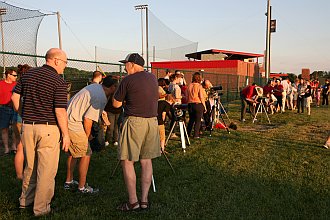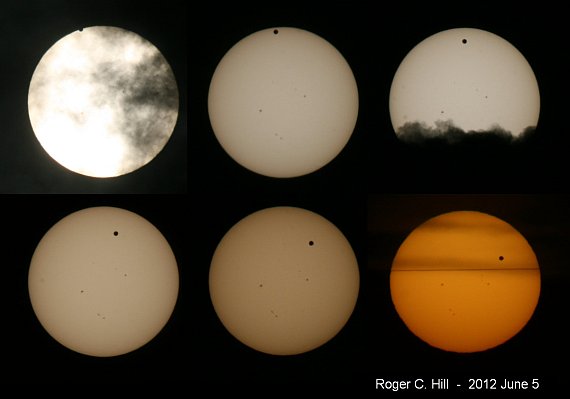
Venus is the next planet in from the earth toward the sun (orbit-wise); it is the object that periodically shines brightly in the western evening sky for several months, and later in the eastern pre-dawn sky for several months. As Venus goes from an evening to a morning spectacle, it comes between the earth and the sun — but usually not exactly, because the orbits of Venus and the earth are not quite in the same plane. Sometimes, however, Venus does comes exactly between the earth and the sun, and is then visible (with suitable eye protection) as a tiny black dot crossing the surface of the sun — a "transit of Venus". This happens very rarely; in fact the 2012 transit is only the seventh one whose observation has been documented in recorded history.
In the 2012 transit it took 6 hours and 40 minutes for Venus to cross in front of the sun, as seen from the earth. About half of this was visible from Edwardsville until the sun set. Clouds partly obscured the beginning of the transit, but we were fortunate to have a clear view of the sun most of the time after that (see photo below).
In recent centuries, transits of Venus have been occurring in pairs with two transits 8 years apart. The "companion" to the 2012 transit occurred on June 8, 2004; the last part of it was visible from Edwardsville for a short time after sunrise. On that morning in 2004, a handful of dedicated observers met before dawn on the roof of Founders Hall to get a clear view of the transit when the sun came up. The last two transits before that were in December of 1874 and 1882. The next pair of transits will occur in December of 2117 and 2125.

At the right is a montage of photos taken of the 2012 transit by Physics Emeritus Faculty member Roger Hill during the viewing session, starting with Venus crossing the edge of the sun and ending near sunset when the transit was about halfway through. Clicking this image (or this link) will give a higher-resolution image. The photos were taken with a Canon Digital Rebel XTi and a 400-mm telephoto lens (equivalent to a 640-mm lens on a 35-mm camera), with a filter cutting out 99.99% of the sun's light. Note the sunspots visible in addition to Venus (not to mention the clouds!).
Besides being an interesting and rare curiosity, observations of transits of Venus have been of scientific importance in increasing the accuracy of measurements of distances in the solar system, gaining more information on Venus' atmosphere, and obtaining other astronomical information.